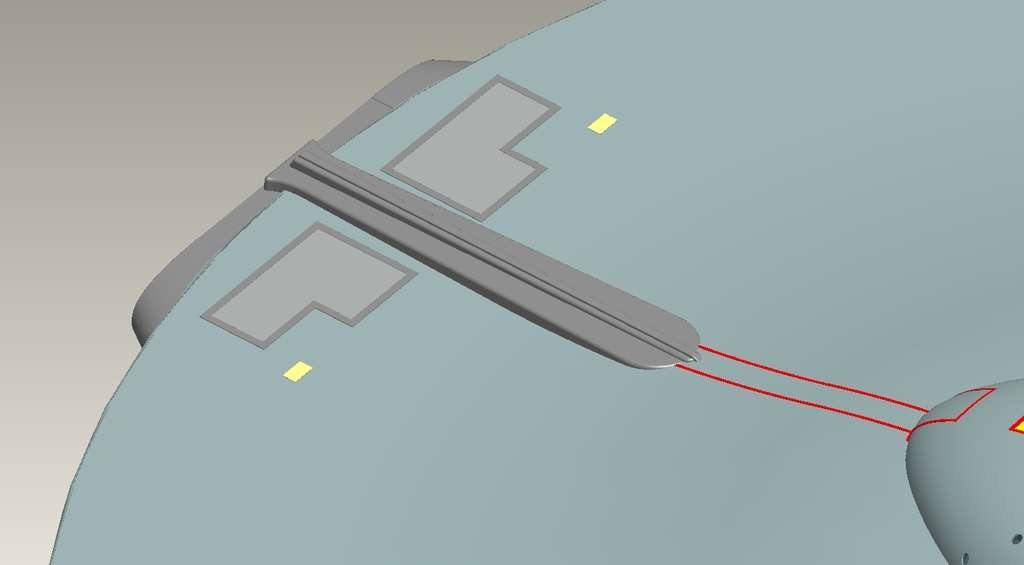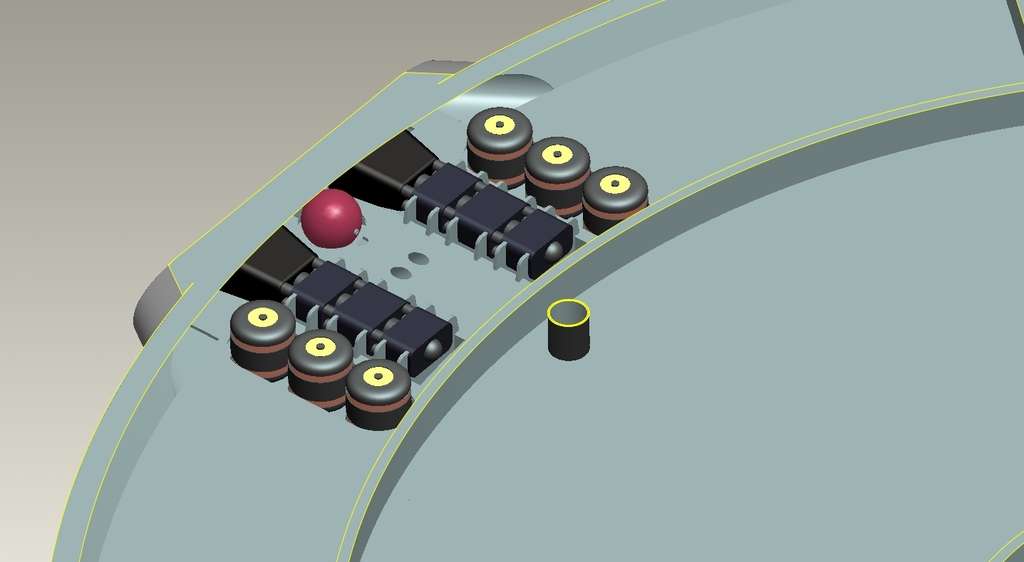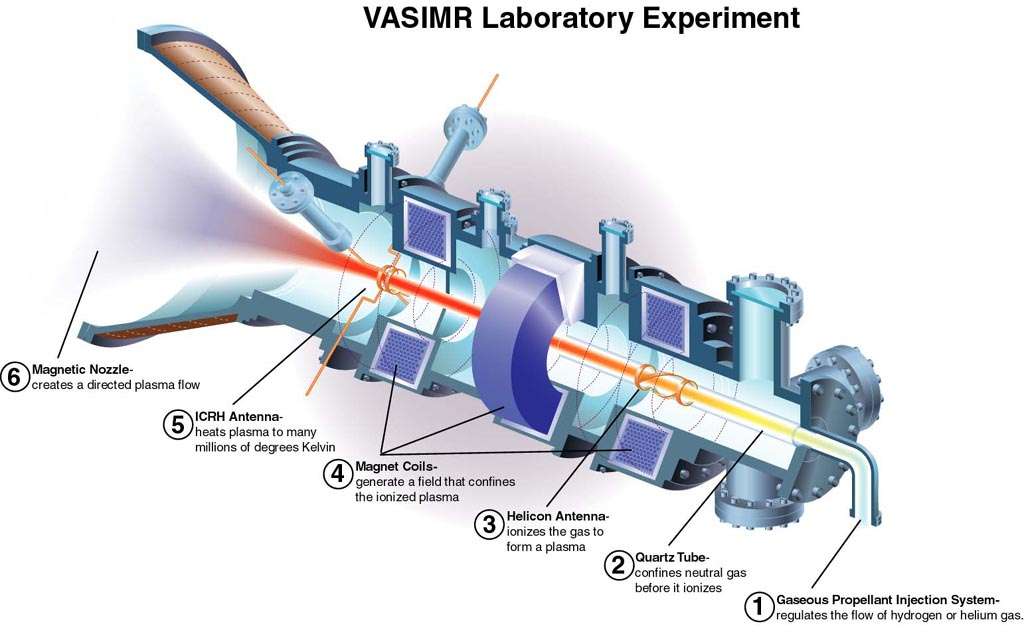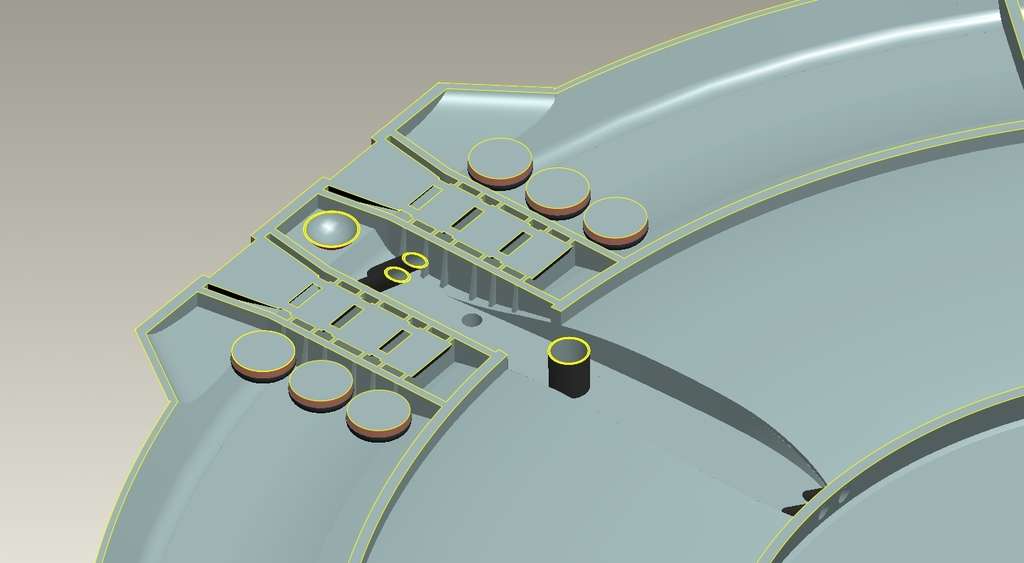Okay, back to work...

Today, I've gotten back into the whole "impulse deck" arrangment.
To help clear things up a bit, I'll start with an outside hull view.
What are we looking at there? Well, we see the aft impulse deck fairing, of course... we all recognize that. We see the "row of ribs" on top, going forward from that. We see the two "L" shaped hatches, and the two yellow rectangles. We also see a pair of red lines tracing forward from the rib set.
Here's what I'm assuming about those various items.
First off... the "L" hatches are analogous to the "T" hatch on the secondary hull underside. This is borne out by the fact that both have the same color scheme (medium-grey interior, dark grey outline). I've decided to use both as fusion-reactor access. In this case, it's a combined-access panel, however, as it will also give access to remove and replace impulse propulsion system components. Note that this is not intended to be an "in-service" repair... we're talking drydock, most likely, though in a pinch they could certainly do some work that way in the field if required. I'd say it would require pretty dire straights, as you'd be depressurizing an entire region of the primary hull, removing major support elements, etc. But it would be possible.
The little yellow bits are covers for the fueling pumps... in a dock situation, these hatches would be retracted and you'd have direct access to the "gas cap."
Note that I've decided, having read a bit more on the detailed functionality of the VASIMR design, that hydrogen will serve perfectly well as my thrust fuel as well as my reactor fuel. Heavier materials work better for generating thrust, but they're also heavier to carry... and with hydrogen able to harvested along the way, it's just a lot more reasonable to use that. The advantages outweigh the disadvantages.
Now, here's the interior on Deck 6, in that region. (Obviously, this is not entirely complete, and the "energizers" and engineering workspaces, to either side, aren't there yet.)
The fuel is normally stored in cryogenic form, in "slush tanks" which aren't seen here. Prior to use, the hydrogen is preheated for preparation - that occurs in the pale maroon tank you see in the middle of the impulse fairing. The idea is that you don't want to be pumping cryogenic slush into your propulsion units, you want pressurized gas. So this is a high-pressure tank. The tank has a "dump port... the central circular bit on the outside of the fairing, between the two impulse thrust ports.
Forward of that, you see the termination points for the two aft-dorsal Jefferies tubes. Immediately forward of that will be a working space, the "impulse monitor room." Note that there will be a fair amount of additional structure added in there, to tie the dorsal mechanical elements to the topside "rib"... this won't just be a big empty open space. There will also be piping to carry the preheated hydrogen to the front of the impulse thrust units, and to the six fusion reactors you see along either side, outboard of the thrusters.
The fusion reactors can be replaced at a dockyard... the "L" hatch opens over the aft-most of the three in each row (and over the aft two segments of the impulse unit). These provide power which is converted, by the energizers, into useable electrical energy, which then in turn drives the thrust units.
The impulse propulsion units, or "thrust units," are basically a dramatically-refined version of the VASIMR engine concept currently under development. Here's a quick image of the VASIMR concept:
The idea is that you inject gas into a magnetically-confined volume (that's what the coils you see are for), convert it into plasma, then superheat that plasma, using electromagnetic devices rather than any form of combustion.
In my case, these impulse propulsion units are three-stage, rather than the two-stage seen with VASIMR, but otherwise fundamentally the same in concept. It's an electrically-driven propulsion system which is dramatically adjustable in terms of thrust output.
Now, I know some folks argue "well, how do you slow down?" That's because they're (mistakenly) assuming that a ship in space must behave in the same fashion that a ship in atmosphere must. That, however, is neither supported by on-screen evidence, nor is it reasonable within the realm of real science.
In this case, if the enterprise is moving at a high "sublight" speed, and needs to reverse thrust... how will it do it? That's very simple. You simply turn the ship around (which can be done by vectoring the thrust output of the main engines, OR by using some form of RCS thrust unit) and decelerate that way.
We have, in the past, discussed (in the "Trek Tech" forum) the idea that you can have something like a "subspace anchor" function provided by your subspace field generator device... which effectively provides a form of drag on the fabric of space/time. I have no objection to that, either, but since that's not universally accepted, and since Enterprise doesn't have "braking engines," and since the main reason we assume that the ship DOESN'T turn around is based upon the viewscreen image (which is a computer generated image composited from all available sensor data, not a "window") consistently showing the direction of travel (which isn't the direction the screen faces anyway!).
There's really no reason to assume that the ship doesn't "flip" to decelerate. In fact, that's what REAL spacecraft normally do... since it's far more cost-effective (in terms of dollars, AND in terms of "weight penalty" and "volume penalty") to have one set of engines than to have two. It's very simple to just turn around, after all...
So, that's the main "braking" system this ship has. If the "subspace anchor" concept is present (and I'm leaving that as an unanswered question)... that's supplementary to the "turning around" manuever, IMHO.
I have no clear about idea what to put out in the corners of the impulse fairing. I've actually given some consideration to putting "static subspace field generators" out there... but I'm hesitant to do so. I could put fuel slush tanks there, though I was planning on having the slush tanks outboard of the engineering spaces (so these would be "supplementary" tanks, not the primary ones). All I know is that we have a pair of "dump ports" to either side of the main impulse thrust ports which are for emergency "cooldown" for the fusion reactors, and which are how the Tycho creature entered the ship in "Obsession."
Going down to Deck 7, you can see a lot more detail with the way that the thrust from the impulse propulsion units transfers its thrust to the ship's main structure. I have a little bit more work to do to tie these into the "dorsal interface" region. Down in this area, under the engines and reactors, will be a lot of hardware and plumbing, accessible primarily through crawlways.
I'm thinking I'll start working on the energizers next...






 ), but where things are different, they still make a lot of sense.
), but where things are different, they still make a lot of sense.


